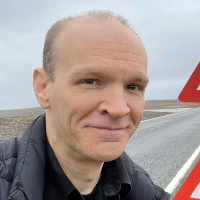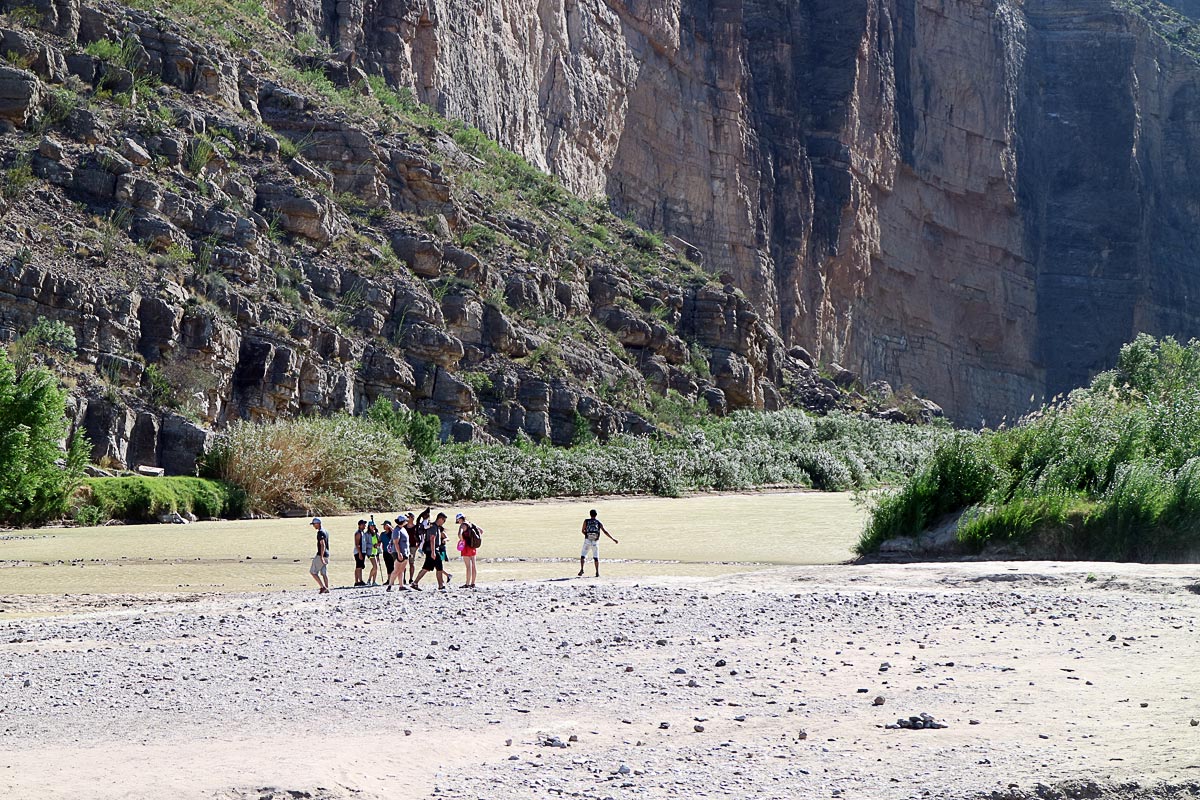
Which way the wind may blow today
Won't be the same tomorrow
Only one eye shows on Jack's face
—Guadalcanal Diary
It’s funny how so many experiences are a mixture of the good and the bad. You can maximize the ecstatic and minimize the tragic, but you do have to accept the totality of your own trip and extract and savor the sublime. A night camping in Big Bend National Park in remote southern Texas demonstrated this dynamic to me starkly: I had one of my better nights of sleep amid frighteningly fierce winds, and woke up happy and refreshed – with the highest blood sugar of the trip so far.
After a night in Van Horn, TX (more of an interstate exit than a real town, it seemed to Masayo and I) we drove down small Texas highways towards Big Bend NP, which is named for a big bend in the Rio Grande, the river that separates Texas from Mexico. The park follows that border, is a rather huge swath of desert and mountain landscape, and sees relatively few visitors due to its remoteness.
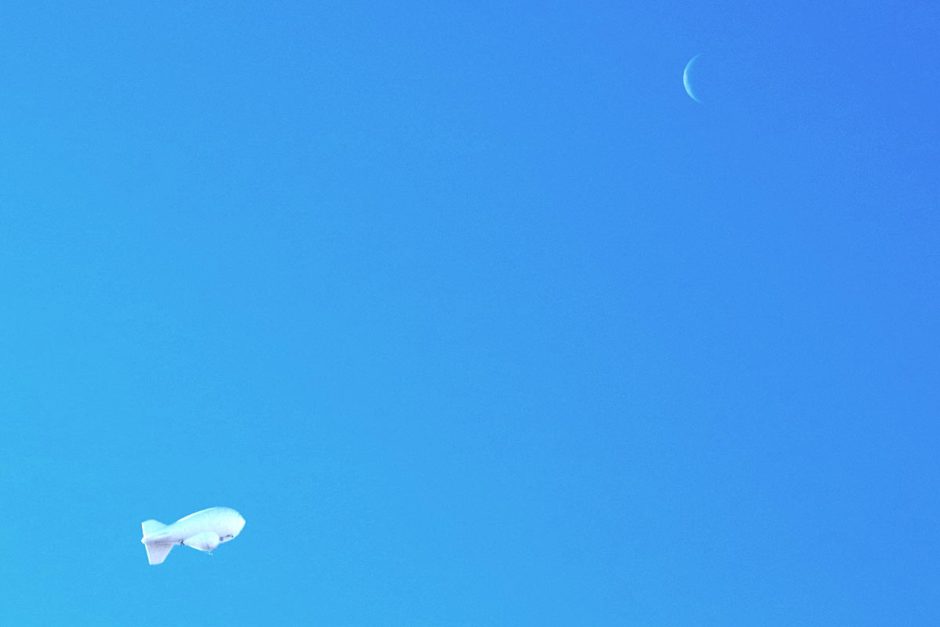
Unexplainable scene above a rural Texas highway.
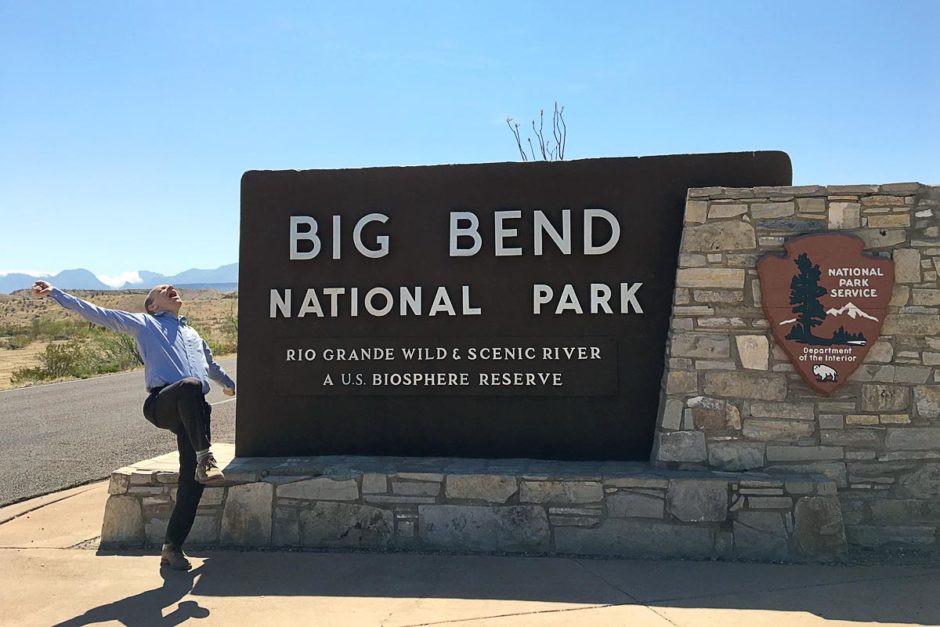
The winds of insanity
It took over an hour to drive all the way across the park from its western entrance to Rio Grande Village campground on the far east side. We pulled into an available campsite and parked the car to have a picnic in our new one-day home.
But the pleasant, sunny weather made it impossible: a strong wind was gusting through the area, blowing large tree branches backwards. Even birds, who never seem to fret about gales of any strength, were having trouble going from limb to limb. Our napkins, bags of chips, and small plastic knives didn’t stand a chance.
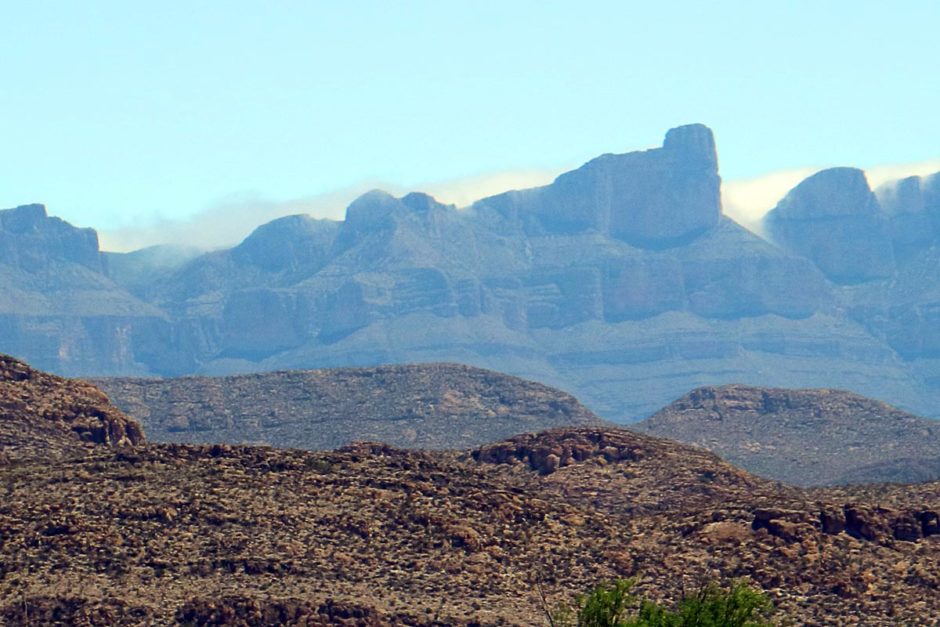
We ate in the car, watching people’s tents getting blown flat and campers staggering along the paths with stacks of dishes for washing in the nearby sink, trying not to fall over. We weren’t sure our cheap little tent could withstand this wind. It might be a night of sleeping in the car.
Scenic drive to Santa Elena Canyon
After the dashboard picnic we drove back to the heart of the Park to drive along the Ross Maxwell Scenic Drive. The 30-mile winding paved road passes through some stunning formations, rocky mountains streaked with unusual horizontal lines, supporting dramatic elevated spires, and situated among alternating fields of creosote and soft, rolling hills decorated with tall, thin sotol plants. Words sprang poetically to mind, a frequent one being “vast”.
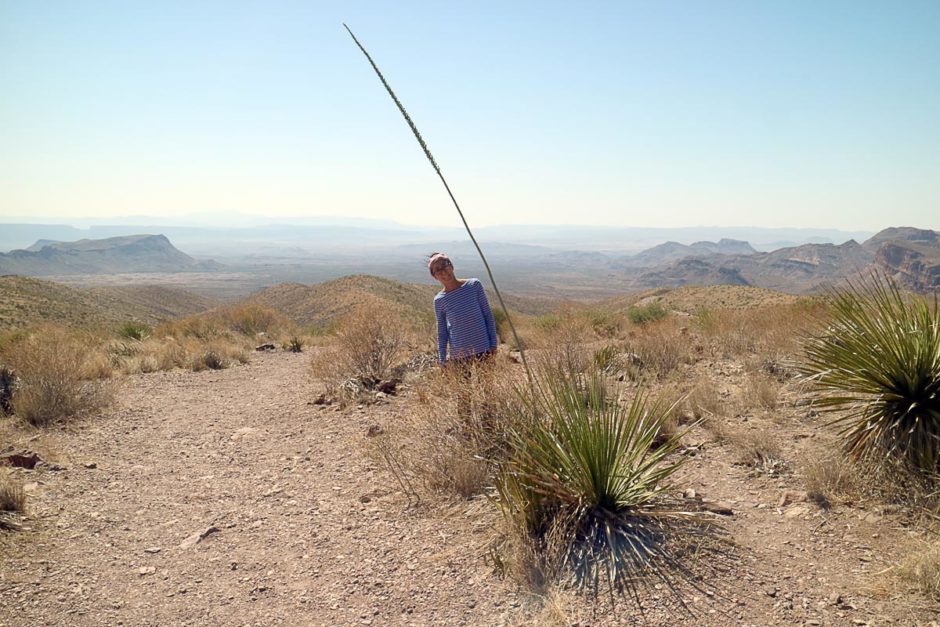
Masayo and a sotol plant.
We hopped out of the car at various points, trying to capture in our digital cameras the look and feel of being in terrain of such magnitude and grandeur. As has happened at so many National Parks on this trip, getting nice photos was easy; accurately recording the actual experience of being there, less so.
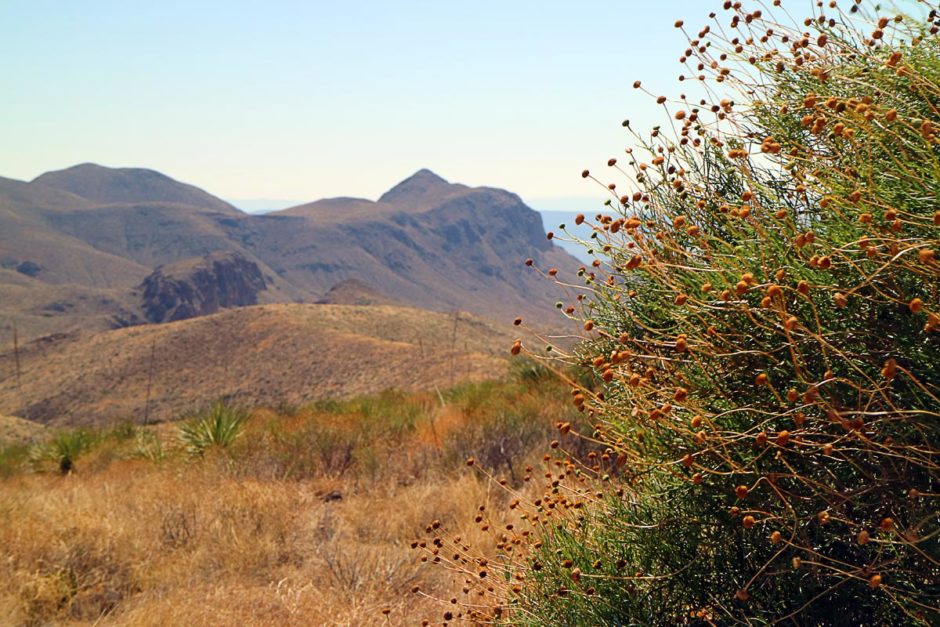
At the end of the Scenic Drive is Santa Elena Canyon, which has been cut from an otherwise straight and imposing row of cliffs by the Rio Grande. The canyon creates a gap in the cliffs visible from many miles away, and as a tourist sign explains at a point further in the park (paraphrasing), “That gap on the horizon may look tiny now but just you wait ’til you get there, punk. You’ll see.”
We saw. Santa Elena Canyon isn’t gigantic, exactly, but its sheer walls do rise dizzyingly high from a human perspective, and the muddy brown river and eruption of greenery all around emphasize the utter change from the arid and dusty rocks all around it. A truly dramatic oasis, it’s instantly obvious why this canyon would serve as a landmark every bit as inviting and important as the El Capitan peak in Guadalupe Mountains National Park.
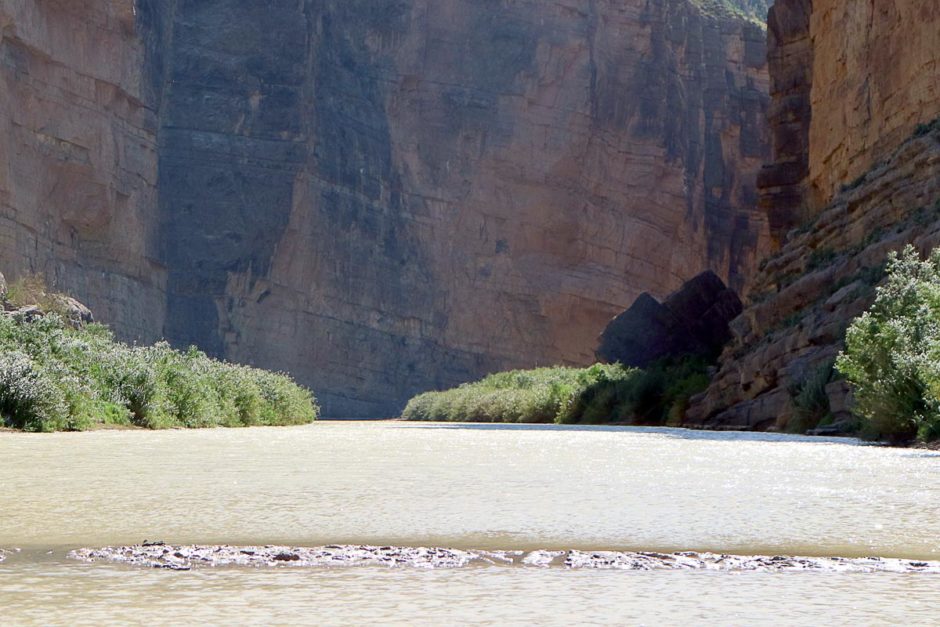
Santa Elena Canyon.
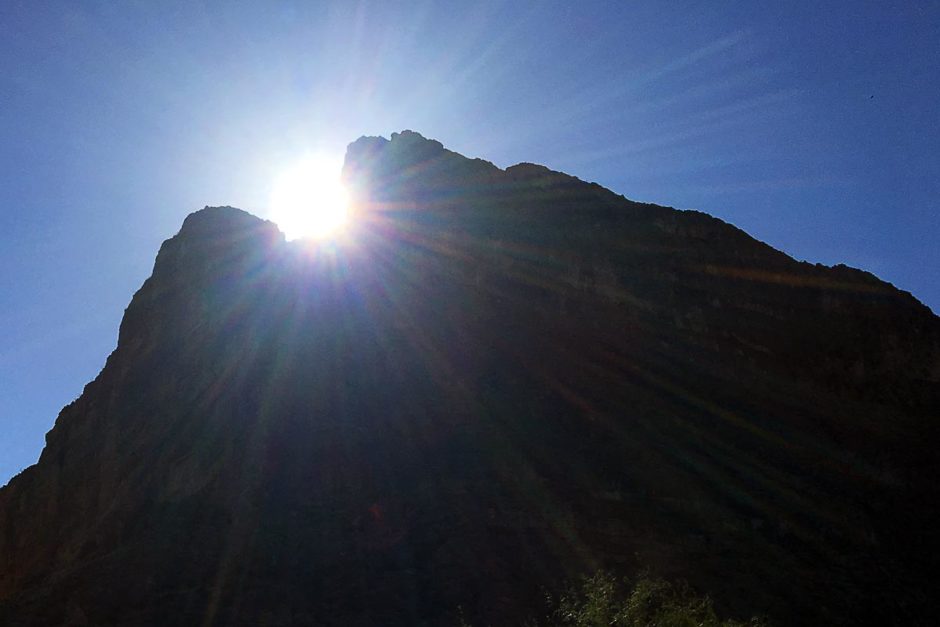
Several other people were at Santa Elena Canyon on this late afternoon; the small parking lot was almost at capacity as the sun approached the top of the canyon walls and the great shadows got weirder and larger. Some carried kayaks, perhaps embarking on multiple-day river adventures; others toted babies in slings for a quick peek at one of America’s premier waterways.
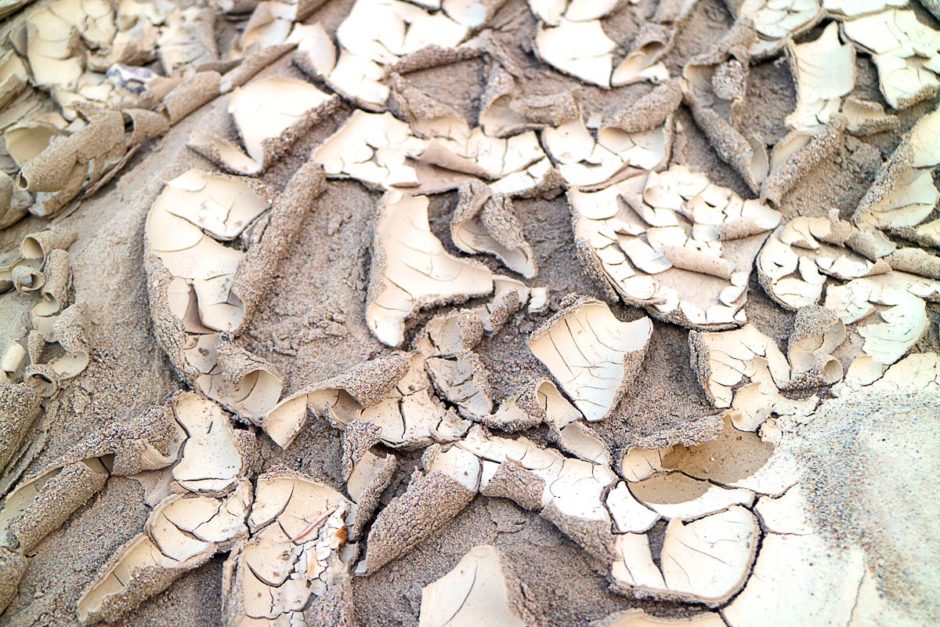
Masayo and I walked to the water’s edge, tried to avoid slipping in the mud, and gasped up at the walls of Santa Elena that glittered into grey in the warmish sunlight. The air was pleasant and moist, the chattering of those around us happy and exhilarated, the purr of the calm tan-green waters at once soothing and indifferent.
Our battle with campsite poachers
We were still wondering how we were going to handle the wind at the campsite and our tent. Before leaving, a ranger had approached the car while we sat inside eating lunch and advised us to move to a different spot to avoid flooding from irrigation happening that night. So we did; our new campsite was rather ugly, sand and gravel between dead grey tree branches with a row of electrical poles hiding otherwise unbroken views of a mountain range – but it was out of the wind and out of the flood area.
Claiming a campsite in Big Bend NP
Like many parks, our campground at Big Bend was first-come, first-served; you can’t make reservations from your motel room the day before and saunter into the park whenever you want. We’d awoken before 7:00 am in Van Horn for the drive down, trying to arrive by 10 am to get a campsite in Chisos Mountains, the most scenic and thus popular tent camping area of the park. It being a Saturday in spring, and a nationwide free admission weekend, the ranger on the phone the day before had advised me the earlier the better.
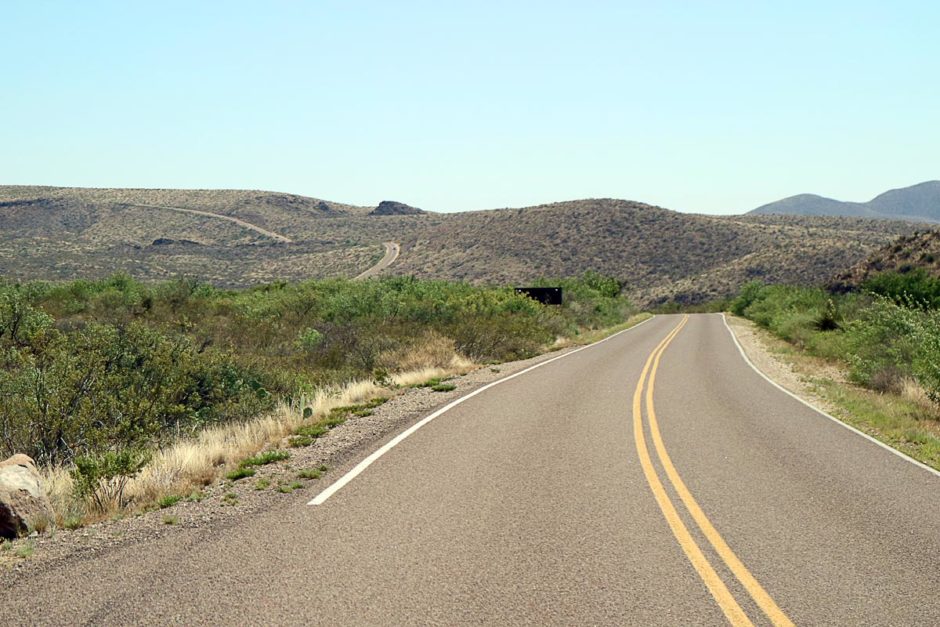
The road between Van Horn and Marfa was undergoing construction, I was stuck behind a semi, and going was much slower than I’d hoped. The road after Marfa rose into the mountains, and there were fast-moving, very dark and low clouds overhead. It was kind of freaky and made for even slower driving. We arrived at Big Bend’s western entrance around noon.
The ranger at the entrance station said there were still two available sites at Chisos Mountains, but it was still a 45-minute drive there. He didn’t sound hopeful that we could secure a spot.
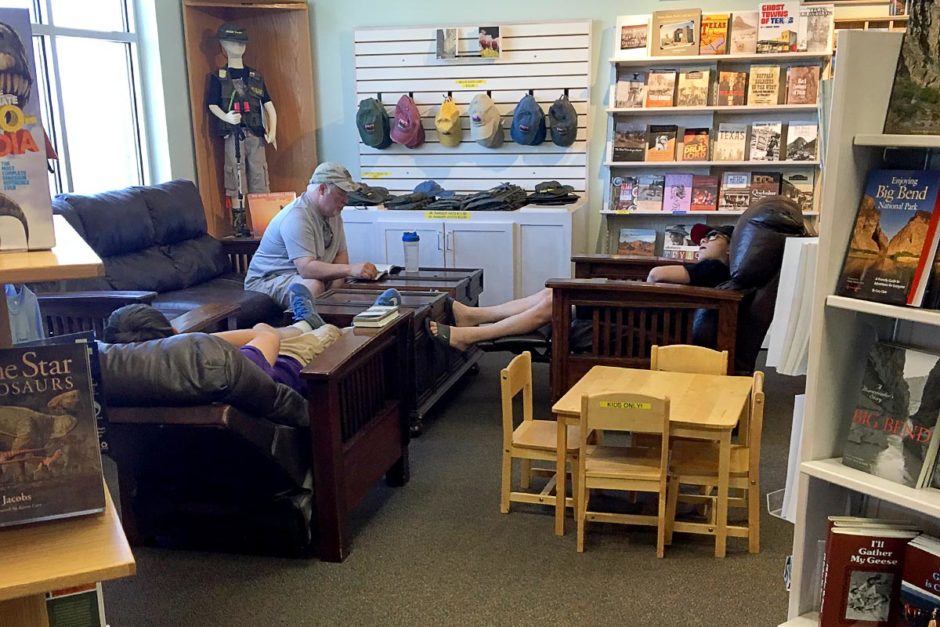
Panther Junction Visitor Center has the first lounge I’ve seen in a National Park on this trip.
And we didn’t; a sign said FULL when we got there, which is why we ended up at the far east end of the park in Rio Grande Village, with the wind and the threat of flooding.
And after moving to the ugly but less-windy campsite, we marked our territory in the prescribed way: after putting our payment in an envelope at the campground’s entrance, I tore off the pay stub and attached it to the pole beside the campsite. As the ranger advised me, I also put a gallon bottle of water on the picnic table just to make it obvious that someone had claimed the place.
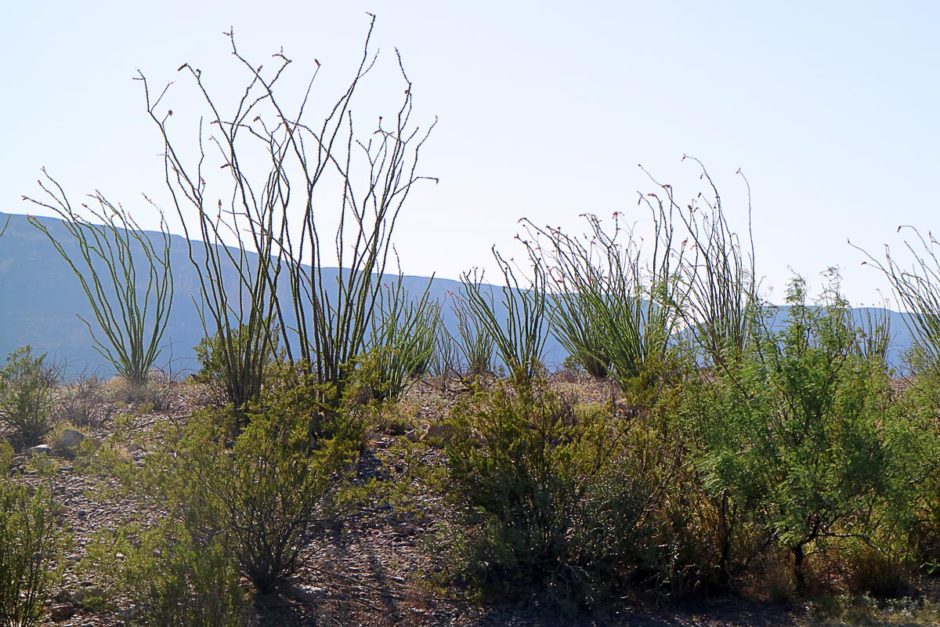
Ocotillo plants, with Santa Elena Canyon (that gap) far in the background.
When looking for a spot, you just drive around and look for a site that doesn’t have a pay stub attached to the pole, and you make sure that there are no belongings in the site. If everything looks empty, it’s yours.
Well after driving back from Santa Elena Canyon, we pulled up to find a car parked in our spot, with a tent up and a woman sitting at the table, food spread out. Huffing, I got out of the car and confronted her.
She claimed that she had asked a ranger because she wasn’t sure if the spot was available. I’m not sure what she meant – what ranger? How would they know? Our pay stub was still stuck to the pole; her food was sitting beside my bottle of water. Clearly this was someone’s campsite. I think she just didn’t want to camp in the open wind and stole our site.
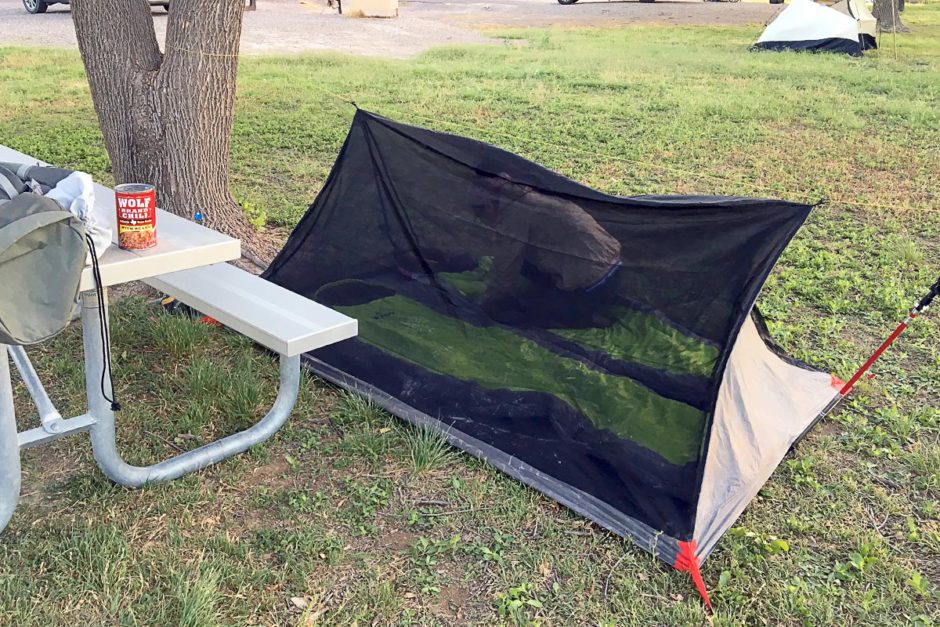
But I didn’t want to make an older woman rip up her tent and move, so as Masayo ripped off the pay stub from the pole and wave it at her (which didn’t seem to change the woman’s mind) we got back in the car, hoping there was another space.
There was – in the flat, open, windy part. But, as far as we could tell, out of range of the flooding area. As the wind blew crazily through the campsite, making conversation difficult, we managed to get the tent up and even cook chili.
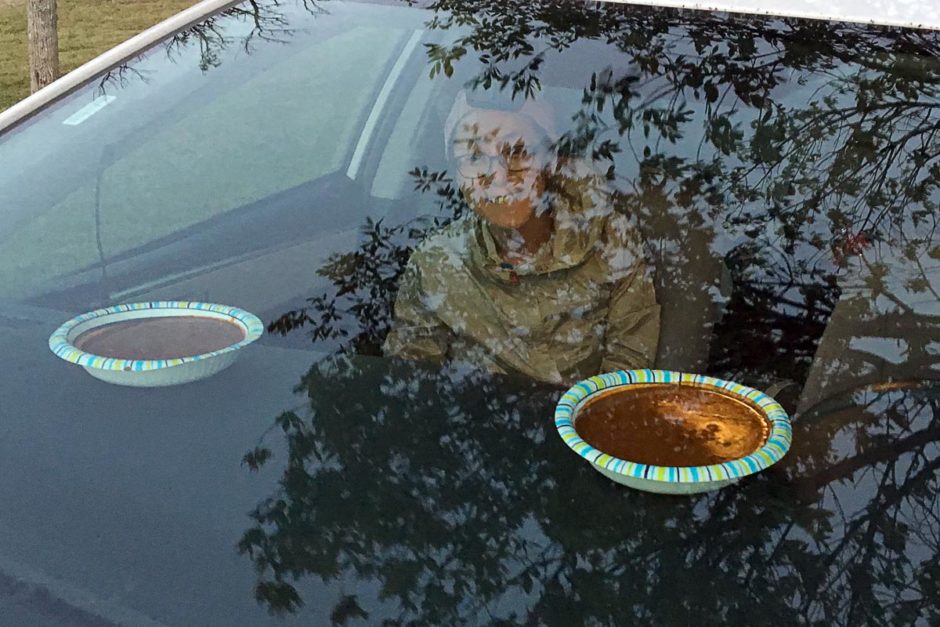
Again, we ate in the car, and tried to count our blessings. Some lady, either dim or dishonest, had stolen our campsite, but while we now had to deal with the wind, at least we would be sleeping on flat grass and not hard gravel. If our tent didn’t blow us several miles into Mexico overnight, maybe it would be all right.
But that’s a big if.
The ranger had said the wind was expected to die down “at night” but wasn’t sure when. Our tent, the steadying rope of which was tied around a tree at one end and propped up with a ridiculously swaying hiking pole at the other, was repeatedly blown out of shape but never collapsed.
The stars were out in great display again, as they have been on every camping night of this trip so far. Again, as I lay on my back in the tent and looked up through the thin mesh, I could see the Big Dipper right overhead. Soon, having been up before 7 am on three consecutive days, I slumbered.
It was the best night of sleep on the trip so far. Despite the wind gusts, I was on cool, soft grass; I was tired and thankful to be sleeping. Despite the other campers – an unusually inconsiderate bunch who kept turning on headlights, talking too loudly, and letting their dogs bark – I was loving this night.
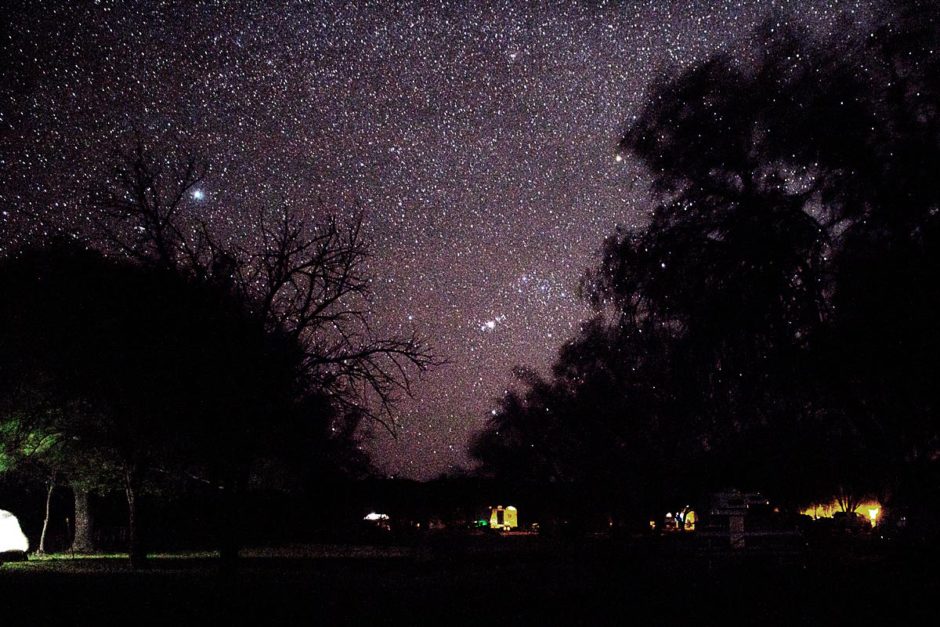
In the morning, Masayo and I both remarked on how refreshed and well-rested we felt. It’s taken a couple of weeks but we’re starting to feel the great pull of the outdoors, of sleeping under the stars and fending (to a degree) for ourselves. Of eating simple, mostly-warmed camping food and not being able to relax on a sofa at night. Just drifting off to the sounds of the wind, the stark darkness of the unbroken sky, and sharp hissing of the leaves overhead, and the soft earth underneath.
Which made my first blood sugar check of the day a little stranger: as the sun popped over the mountains and warmed up the campsite – and with the wind having finally calmed down – I poked a finger while waiting for water to boil for coffee and checked with my One Drop meter: 355. The highest of the trip to this point.
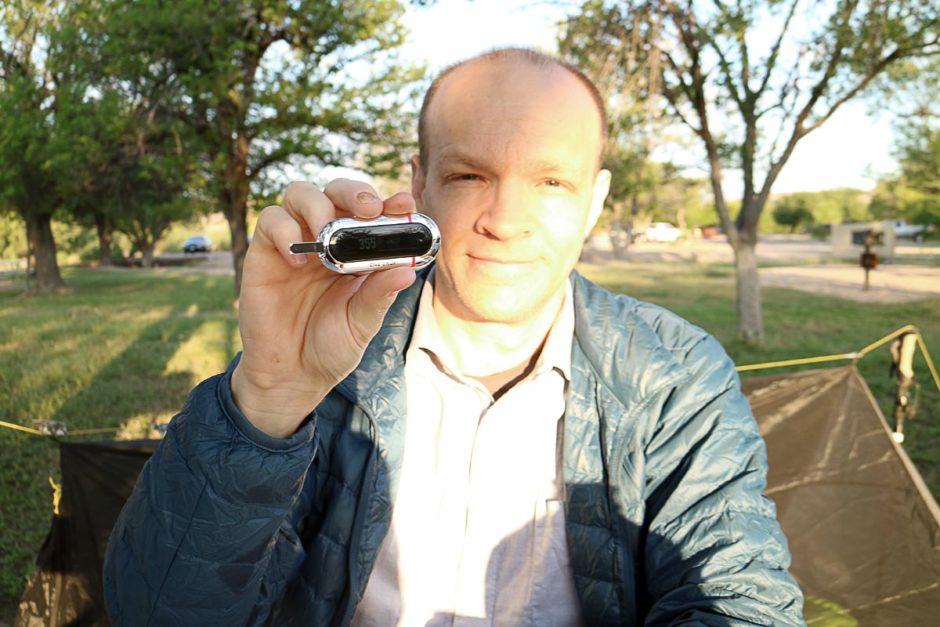
BG 355, but hey, nice morning!
I didn’t know why; I knew what I ate for dinner and what I injected for it. Must have been some kind of stress overnight? Usually a high blood sugar will wreck sleep in some way, but I now sat in mild shock (or at least irritation) at the number (which I could feel was in fact correct).
But the feeling of restfulness and happiness didn’t dissipate. It was a disappointing number, but the restorative power of sleeping outside in Big Bend National Park couldn’t be undone by a mere single BG reading. That’s how good the camping was.
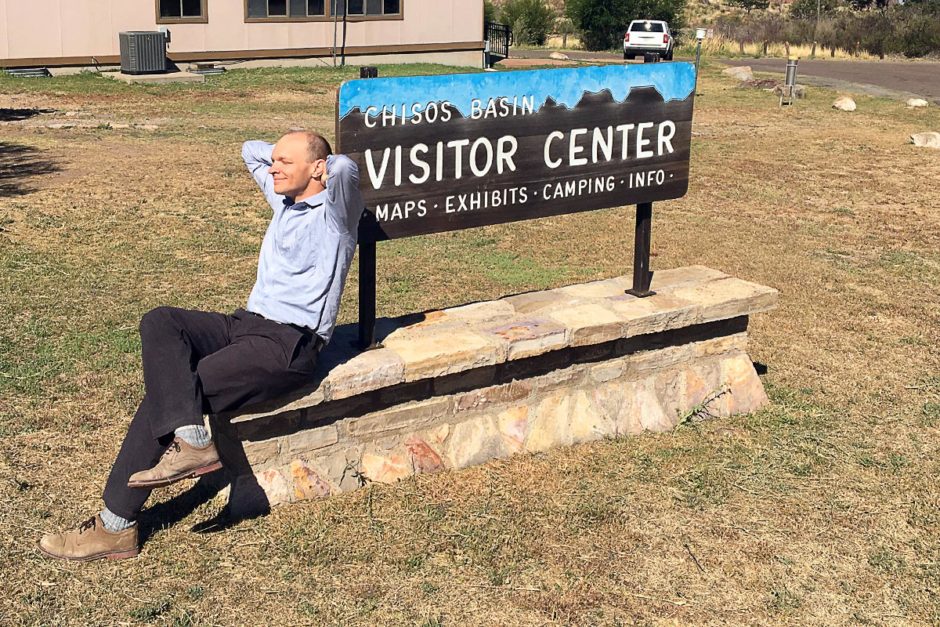
Morning zoo
Big Bend gave us quite a show of animals as we drove around the park one last time before leaving. If we’d had an animal checklist we’d have been able to mark quite a few off of it just in the space of a couple hours:
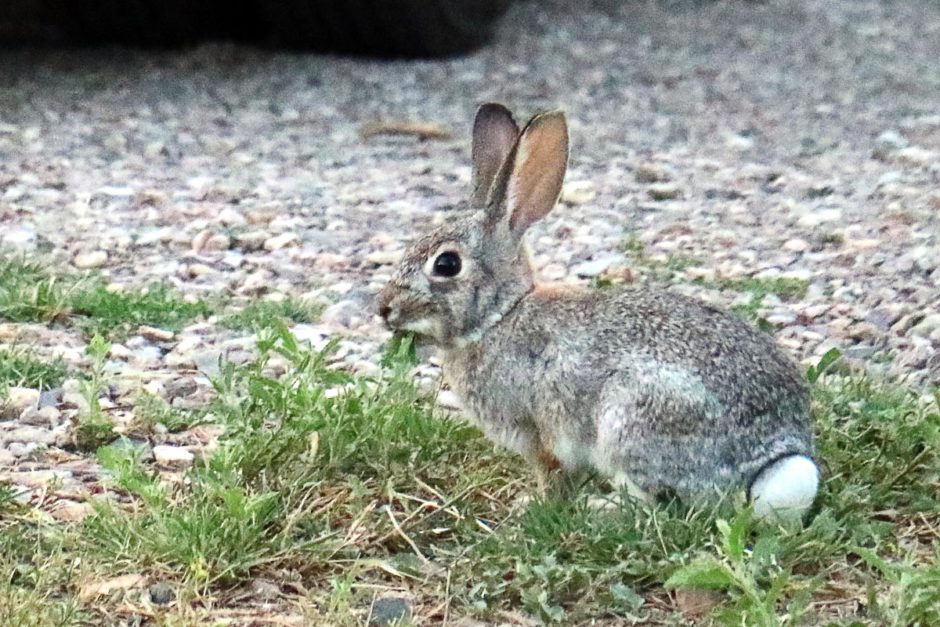
- Rabbits
Even before heating up water for coffee, the first thing I saw upon getting out of the tent around 7:00 was two rabbits nearby, hopping erratically and chewing on grass.
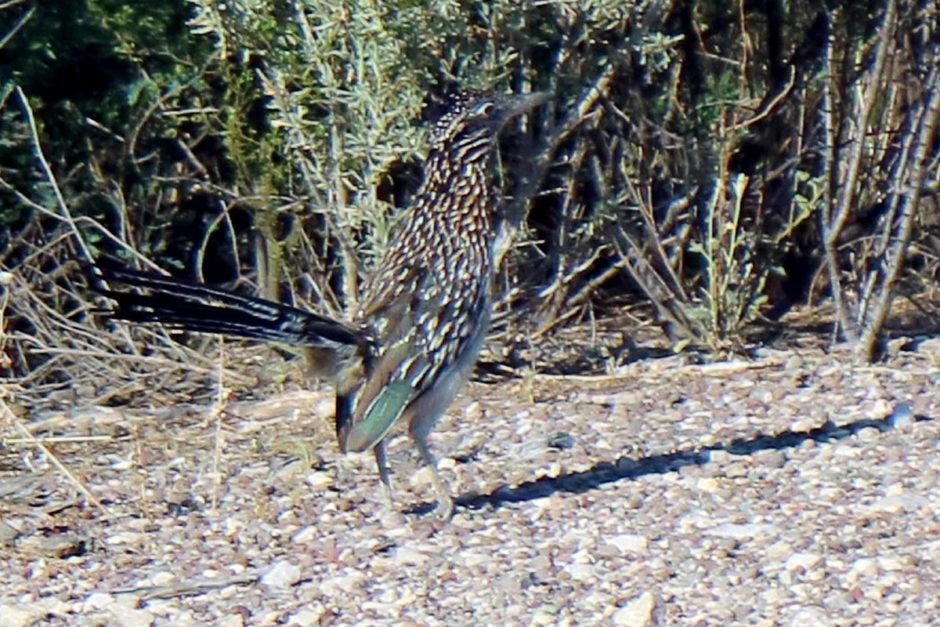
- Roadrunner
At first I saw him from a distance, skittering around the campground with impressive, lightning-fast legs. As we drove out of the campground he was right beside the car, doing his funky thing beside the road.
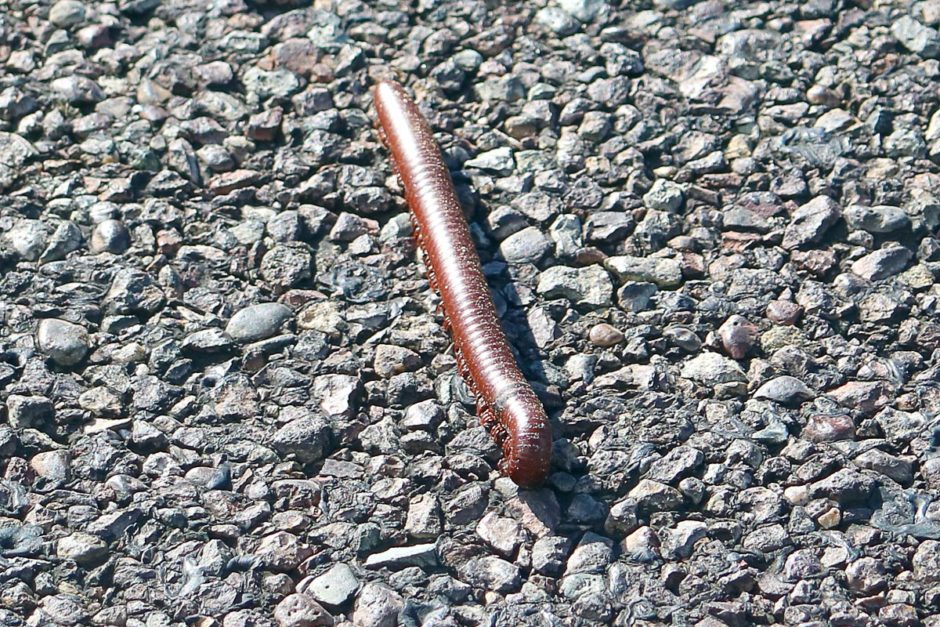
- Millipede
Or whatever. I kept seeing these short little red lines in the road, and noticed they were moving. It was fun dodging them in the car (like playing Turbo, if you know that 1980s video game). Finally I stopped to get a closer look at one. Their ritual of crossing the road must be a dangerous one, but they were rather attractive as far as creepy crawly things go.
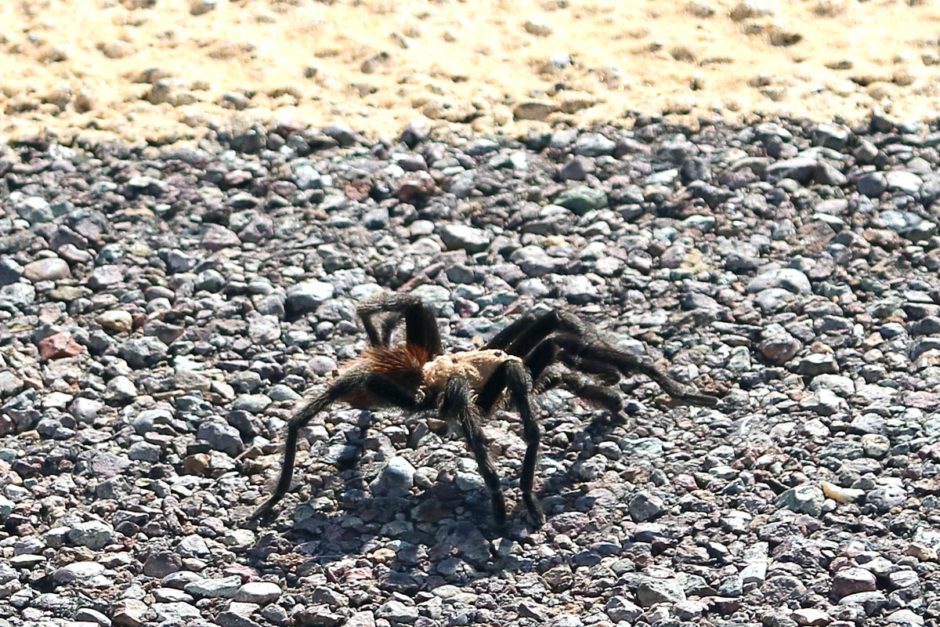
- Tarantula
I visited Big Bend NP several years ago with friends, and into our campsite crawled a tarantula one night. So on this current trip, the large hairy beasts were on my mind; I even asked a ranger about them when we arrived. (He alternately told me there’d be no problem, that the spiders weren’t aggressive or dangerous, and that a bite could send me into shock that, in this remote place, could kill me. Thanks, Ranger.) The campsite was safe but I did see one crossing the road, and actually turned the car around to go get a closer look and take some hurried photos (they move fast). Shudder.
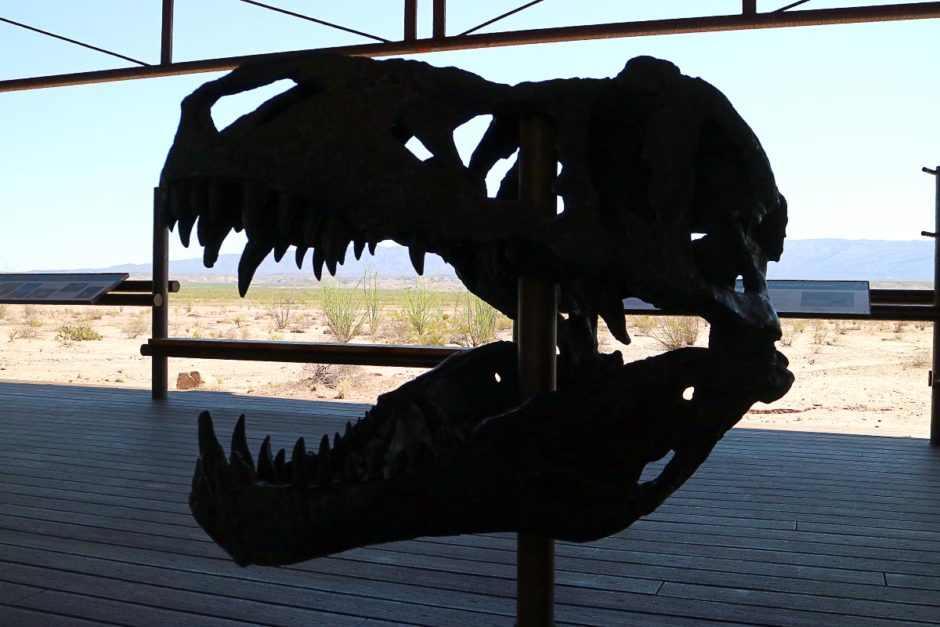
- Dinosaurs
Dinosaur fossils have been plentiful in Big Bend, and a fantastic display towards the north entrance of the Park shows their size and explains the history of archaeology in the area. These things were massive and amazing, and the displays are fascinating.
What we didn’t see are bears or mountain lions (in the Chisos Mountains) or coyotes. Oh well; maybe next time.
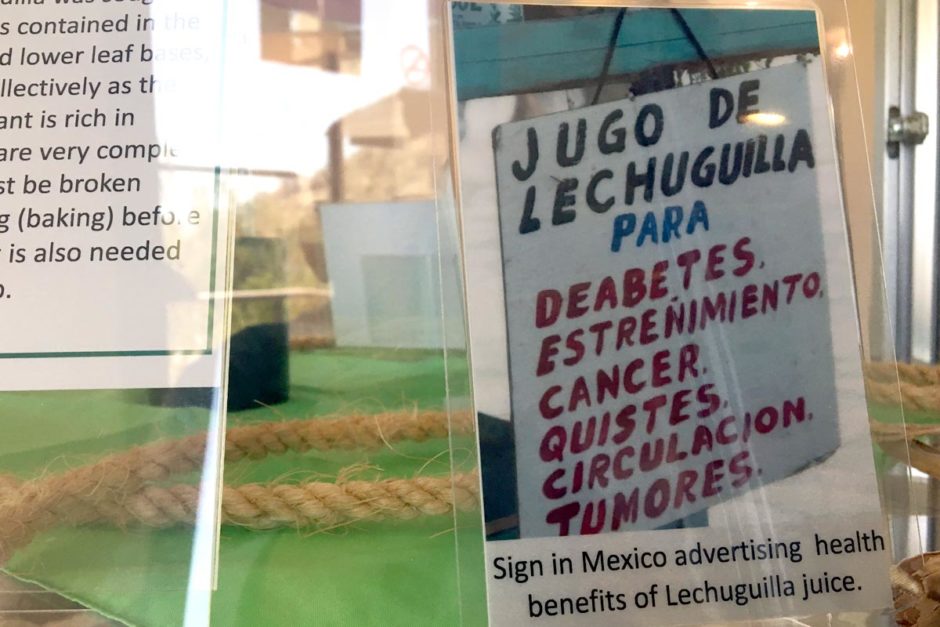
The lechuguilla agave plant helps treat diabetes, according to this old ad (from a Big Bend Visitor Center display).
Big Bend National Park, despite its remoteness and large distances, is an absorbing place to go and spend at least one night. There are a lot of different types of terrain to behold and an inexhaustible supply of breathtaking views around every turn in the road or along its numerous hiking trails.
As for me, I spent the night in a wind-blown tent with super-high blood sugar, grumbling about having my original campsite whisked away from me, but managed to have the most peaceful and restful sleep of the trip so far. If that’s not a testament to the primitive and natural powers of spending time in the Park, then nothing is.
Thanks for reading. Suggested:
- Share:
- Read: Day 21: Remember the San Antonio Missions National Historical Park
- Join: Free email newsletter (info and early video access)
- Support: Patreon (much earlier video access and other perks)
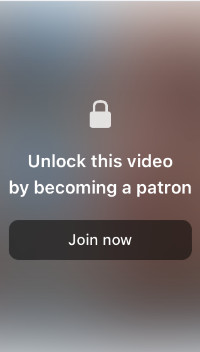
Support independent travel content
You can support my work via Patreon. Get early links to new videos, shout-outs in my videos, and other perks for as little as $1/month.
Your support helps me make more videos and bring you travels from interesting and lesser-known places. Join us! See details, perks, and support tiers at patreon.com/t1dwanderer. Thanks!
Want more? Get the free newsletter
Join us! Sign up to my email newsletter to receive updates, behind-the-scenes info,
and early links to my new YouTube videos before everyone else
